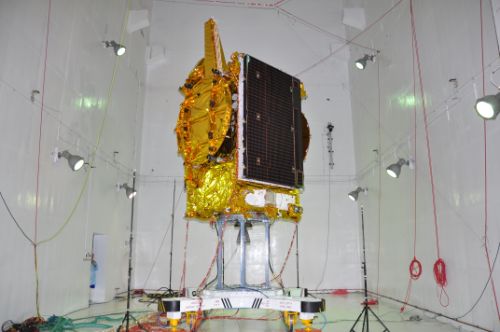India’s GSAT-19 Reaches Geostationary Orbit after Off-Target Injection
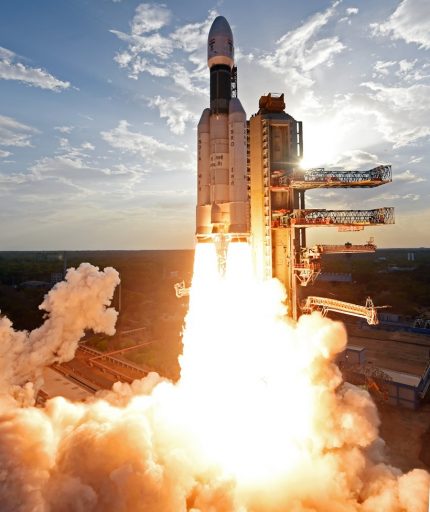
India’s GSAT-19 satellite reached a near-Geostationary Orbit on Saturday after a re-planned orbit-raising campaign that was necessitated by a slightly off-target delivery of the high-throughput communications satellite by the new GSLV Mk. III launch vehicle.
GSAT-19 became the heaviest satellite launched from Indian soil on Monday when taking flight atop the GSLV Mk. III, making its first all-up orbital test flight to become the newest and most-powerful member in India’s launcher fleet.
GSLV Mk. III blasted off from the Second Launch Pad at the Satish Dhawan Space Center at 11:58 UTC on Monday under the power of its two large Solid Rocket Boosters, outputting a maximum liftoff thrust of 1,050 metric-ton force. Monday’s liftoff marked a major achievement for the Indian Space Research Organization after 16 years of work on the Geosynchronous Satellite Launch Vehicle Mark III that is ultimately envisioned to handle heavy Geotransfer missions supporting all of India’s satellite programs that currently rely on foreign launchers.
Blazing away from India’s East Coast toward the south East, GSLV Mk. III fired up its two-engine L110 core stage one minute and 55 seconds into the flight followed 26 seconds later by the separation of the spent boosters. The core stage and its twin Vikas 2 engines delivered 156 metric ton-force of thrust over a burn of three minutes and 23 seconds, in the process accelerating the stack to 4.0 kilometers per second (relative velocity).
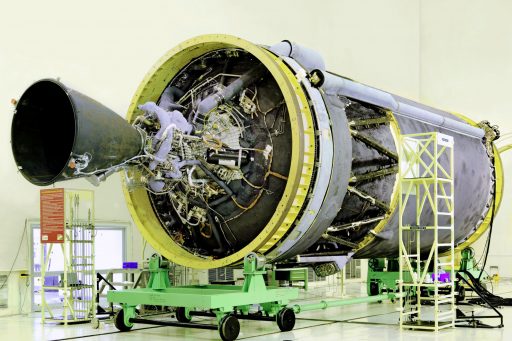
This set up for the moment of truth, coming when the C25 Cryogenic Upper Stage fired up its 200-Kilonewton CE-20 engine, India’s most-powerful cryogenic rocket engine developed to date. C25 and its engine in particular had been the primary reason for GSLV Mk. III falling seven years behind its original project schedule and all eyes were on the screens at Mission Control displaying the launcher’s trajectory as the third assumed control of propulsive flight.
Per the original flight plan, the C25 cryo stage was planned to fire for ten minutes and 43 seconds to accelerate the stack by 5.8 Kilometers per second to reach the planned injection speed of 9.8 km/s. However, Launch Control displays showed a not insignificant overperformance, meaning the stage was accelerating faster than predicted through mission simulations.
This in itself is not uncommon especially for a completely new rocket stage for which only theoretical performance models exit.
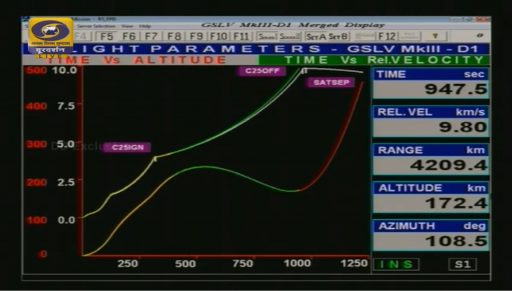
However, it requires a guidance system capable of detecting the overperformance and adjusting the flight path to reach the proper orbit and shut the engine down early once the desired injection speed/orbit are reached.
GSLV Mk. III appeared to do just that, ending the CE-20 burn after ten minutes and 24.8 seconds – 18 seconds earlier than was planned per the pre-flight prediction. The satellite separated as expected 15 seconds after the end of powered flight and GSLV Mk. III’s first orbital mission was declared a full success.
Initial tracking elements provided by the Joint Space Operations Center showed GSAT-19 in an orbit of 158 by 34,579 Kilometers, inclined 21.55°. This orbit was over 1,000 Kilometers short on apogee compared to the planned injection orbit of 170 by 35,975 Kilometers, 21.5°. In terms of change in velocity, GSAT-19 needed an additional 15m/s to make up for the shortfall – not particularly dramatic, but enough to change the planned orbit-raising scheme that called for three maneuvers to be carried out around apogee to circularize the orbit and reduce the orbital inclination to zero in order to put the craft into a drift orbit near GEO.
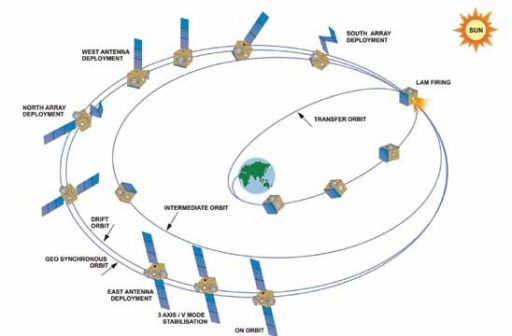
This plan was changed and a supplementary maneuver was inserted to make up for the off-target injection. GSAT-19 fired up its Liquid Apogee Motor at 8:33 UTC on Tuesday when passing the low point of its orbit in order to raise the apogee to what was expected at orbital insertion. The 116-second firing of the 440-Newton LAM changed the vehicle’s velocity by ~16m/s and placed GSAT-19 into an orbit of 173 x 35,938 Kilometers.
From there, the satellite continued as planned with a three-burn GEO transfer. LAM fired up again at 10:14 UTC on June 7 for a lengthy burn of 5538 seconds that changed the craft’s velocity by around 900m/s and put it into an orbit of 10,287 by 35,840 Kilometers at an inclination of 7.02 degrees. The next burn was 3469 seconds in duration and began at 4:25 UTC on June 9, providing a delta-v of just over 700 meters per second and placing the satellite in a 30,208 by 35,875-Kilometer orbit, inclined 0.79 degrees.
The third and final orbit-raising maneuver occurred at 2:29 UTC on Saturday, June 10 and lasted 488 seconds for a delta-v of around 110 meters per second, boosting the satellite into a Geostationary Drift Orbit of 35,470 x 35,869 Kilometers, inclined 0.1 degrees. ISRO also confirmed on Saturday that GSAT-19 successfully deployed both of its solar arrays at 10:45 UTC followed by the deployment of the two antenna reflectors and the acquisition of three-axis control by 14:12 UTC.
GSAT-19 is now set for a period of orbital fine-tuning to enable the satellite to become fully stationary at its initial orbital location.

In terms of propellant reserves for the operational mission of the craft, the supplementary maneuver needed due to the slightly off-target injection will have negligible or no consequences at all. Conservative calculations show GSAT-19 consumed around 1,360 Kilograms of propellant firing the LAM engine, plus a smaller quantity spent for attitude control, leaving at least 300kg of propellant onboard the satellite which will be sufficient for almost 12 years of stationkeeping maneuvers. GSAT-19 has been designed for a nominal service life of 10 years.
Nevertheless, the slightly off-target delivery means work for ISRO’s engineers, now tasked with tweaking GSLV’s guidance algorithm – taking into account actual performance numbers of C25 for future missions and refining the vehicle’s response to changes in performance in flight to ensure future missions will accomplish more accurate injections.
ISRO will eventually switch all of India’s satellite launches to its own launchers and also plans to offer rides on both GSLV versions on the commercial market once the vehicles have fully proven themselves. For the Mark III variant, the next mission won’t come until 2018 with a tentative launch date in January with the GSAT-20 satellite that will debut a new satellite platform and put GSLV’s enhanced performance to the test.
GSAT-19 is now ready to head into testing before beginning operational services with a high-throughput Ka/Ku-Band payload to support data-intensive telecommunications with a total capacity of 4Gbps. The satellite also hosts a number of advanced satellite technologies like Indian-built Li-Ion batteries, miniaturized heat pipe technology for more efficient thermal regulation, fiber-optic gyros for attitude determination, Micro Electro-Mechanical (MEMS) accelerometers, and a Ku-Band telemetry/telecommand transponder.

